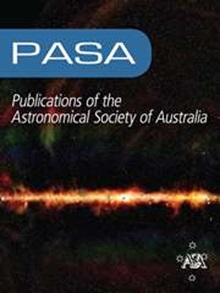HINORA,在三维点分布中检测环状结构的方法 I:应用于局部体积星系目录
IF 4.6
3区 物理与天体物理
Q1 ASTRONOMY & ASTROPHYSICS
Publications of the Astronomical Society of Australia
Pub Date : 2024-03-19
DOI:10.1017/pasa.2024.21
引用次数: 0
摘要
我们提出了一种新方法--HINORA(HIgh-NOise RANdom SAmple Consensus)--用于识别三维点分布中的规则结构。受可能存在所谓的 "巨人理事会"(Council of Giants)的启发,我们将 HINORA 应用于本地体积星系目录,证实了它的存在。当改变进入目录的星系的K波段光度下限时,我们进一步报告说,在本地卷中还存在另一个环状结构,它现在包含了银河系和M31。不过,这个新发现的结构主要是由低质量(卫星)星系组成的。虽然我们在这里只是简单地介绍了这种新方法以及它在观测数据中的首次应用,但利用宇宙结构形成的数值模拟进行的后续工作将揭示星系分布中这种规则模式的起源。此外,这种方法同样适用于在各种天体物理数据中识别类似(甚至不同)的结构(例如在星系红移测量中定位实际的 "重子声振荡球")。本文章由计算机程序翻译,如有差异,请以英文原文为准。
HINORA, a method for detecting ring-like structures in 3D point distributions I: application to the Local Volume Galaxy catalogue
We present a new method – called HINORA (HIgh-NOise RANdom SAmple Consensus) – for the identification of regular structures in 3D point distributions. Motivated by the possible existence of the so-called Council of Giants, i.e. a ring of twelve massive galaxies surrounding the Local Group in the Local Sheet with a radius of 3.75 Mpc, we apply HINORA to the Local Volume Galaxy catalogue confirming its existence. When varying the lower limit of K-band luminosity of the galaxy entering the catalogue, we further report on the existence of another ring-like structure in the Local Volume that now contains the MilkyWay and M31. However, this newly found structure is dominated by low-mass (satellite) galaxies. While we here simply present the novel method as well as its first application to observational data, follow-up work using numerical simulations of cosmic structure formation shall shed light into the origin of such regular patterns in the galaxy distribution. Further, the method is equally suited to identify similar (or even different) structures in various kinds of astrophysical data (e.g. locating the actual ‘baryonic-acoustic oscillation spheres’ in galaxy redshift surveys).
求助全文
通过发布文献求助,成功后即可免费获取论文全文。
去求助
来源期刊
CiteScore
5.90
自引率
9.50%
发文量
41
审稿时长
>12 weeks
期刊介绍:
Publications of the Astronomical Society of Australia (PASA) publishes new and significant research in astronomy and astrophysics. PASA covers a wide range of topics within astronomy, including multi-wavelength observations, theoretical modelling, computational astronomy and visualisation. PASA also maintains its heritage of publishing results on southern hemisphere astronomy and on astronomy with Australian facilities.
PASA publishes research papers, review papers and special series on topical issues, making use of expert international reviewers and an experienced Editorial Board. As an electronic-only journal, PASA publishes paper by paper, ensuring a rapid publication rate. There are no page charges. PASA''s Editorial Board approve a certain number of papers per year to be published Open Access without a publication fee.

 求助内容:
求助内容: 应助结果提醒方式:
应助结果提醒方式:


